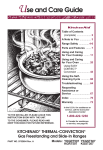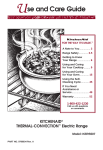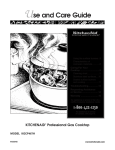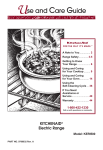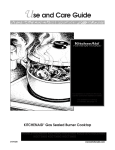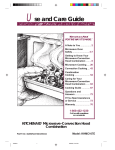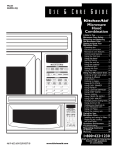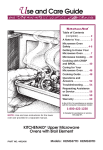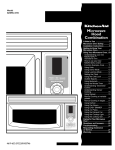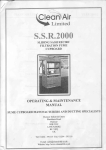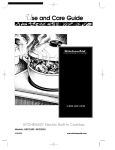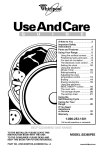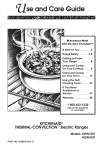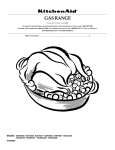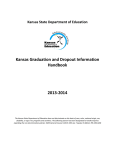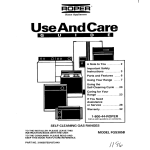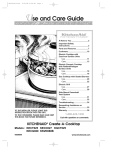Download KitchenAid KGRT500 User's Manual
Transcript
Use and Care Guide Table of Contents .......... 2 A Note to You ................. 3 Range Safety ............... 4-6 Parts and Features ........ 7 Using and Caring for Your Cooktop ............... 11 Using and Caring for Your Oven .................... 19 Using the SelfCleaning Cycle ............. 46 Troubleshooting .......... 51 Requesting Assistance or Service ..................... 54 Index ............................. 58 Warranty ....................... 60 In the U.S.A. for assistance or service, call the Consumer Assistance Center: 1-800-422-1230 TO THE INSTALLER: PLEASE LEAVE THIS INSTRUCTION BOOK WITH THE UNIT. TO THE CONSUMER: PLEASE READ AND KEEP THIS BOOK FOR FUTURE REFERENCE. In Canada for assistance or service, see page 55. KITCHENAID* Gas Freestanding and Slide-In Ranges PART NO. 9752689 Rev. A Models: KGRT500 KGST300 YKGRT500 YKGST300 Table of Contents A Note to You ........................................... 3 Baking or roasting ............................... 29 Range Safety ......................................... 4-6 Cooking tips ........................................ 31 Parts and Features ................................... 7 Adjusting oven temperature ................ 35 Feature locations .................................. 7 Broiling ................................................ 36 The oven vent ....................................... 9 Timed cooking .................................... 40 The storage drawer ............................... 9 Cleaning your oven and controls ........ 43 The anti-tip bracket ............................. 10 Using and Caring for Your Cooktop ..... 11 Using and replacing the oven light(s) ........................................ 45 Using the surface burners ................... 11 Using the Self-Cleaning Cycle .............. 46 Energy saving tips .............................. 14 Before you start .................................. 46 Cookware tips ..................................... 14 Before setting the controls .................. 47 Caring for your cooktop ...................... 15 Setting the controls ............................. 47 Using and replacing the surface light ........................................ 18 For best cleaning results ..................... 50 Using and Caring for Your Oven .......... 19 Troubleshooting ..................................... 51 Using the electronic oven control........ 19 Requesting Assistance or Service ....... 54 Setting the clock ................................. 27 Index ........................................................ 58 Using the timer .................................... 28 Warranty .................................................. 60 How the cycle works ........................... 50 WARNING: If the information in this manual is not followed exactly, a fire or explosion may result causing property damage, personal injury or death. – Do not store or use gasoline or other flammable vapors and liquids in the vicinity of this or any other appliance. – WHAT TO DO IF YOU SMELL GAS • Do not try to light any appliance. • Do not touch any electrical switch; do not use any phone in your building. • Immediately call your gas supplier from a neighbor’s phone. Follow the gas supplier’s instructions. • If you cannot reach your gas supplier, call the fire department. – Installation and service must be performed by a qualified installer, service agency or the gas supplier. 2 A Note to You Thank you for buying a KITCHENAID* appliance! KitchenAid designs the best tools for the most important room in your house. To ensure that you enjoy many years of trouble-free operation, we developed this Use and Care guide. It contains valuable information concerning how to operate and maintain your new appliance properly and safely. Please read it carefully. Also, please complete and mail the enclosed Product Registration Card. In the U.S.A. For assistance or service Call the Consumer Assistance Center toll free ................................................ 1-800-422-1230 Throughout Canada for assistance Call the Consumer Assistance Centre toll free ................................................ 1-800-461-5681 8:30 a.m. – 6 p.m. (EST) Throughout Canada for service ............................................................. see page 55 If you need assistance or service, first see the “Troubleshooting” section of this book. After checking “Troubleshooting,” additional help can be found by checking the “Requesting Assistance or Service” section, or by calling one of the telephone numbers above. When calling, you will need to know your appliance’s complete model number and serial number. You can find this information on the model and serial number label (see diagrams in the “Parts and Features” section). Keep this book and the sales slip together in a safe place for future reference. You must provide proof of purchase or installation date for in-warranty service. Model Number __________________________ Builder/Dealer Name _____________________ Serial Number __________________________ Address _______________________________ Date Installed ___________________________ Phone _________________________________ wWARNING Tip Over Hazard A child or adult can tip the range and be killed. Connect anti-tip bracket to rear range foot. Reconnect the anti-tip bracket, if the range is moved. See the installation instructions for details. Failure to follow these instructions can result in death or serious burns to children and adults. Anti-Tip Bracket Making sure the anti-tip bracket is installed: • Slide range forward. • Look for the anti-tip bracket securely attached to floor. • Slide range back so rear range foot is under anti-tip bracket. Range Foot 3 Range Safety Your safety and the safety of others is very important. We have provided many important safety messages in this manual and on your appliance. Always read and obey all safety messages. This is the safety alert symbol. This symbol alerts you to hazards that can kill or hurt you and others. All safety messages will be preceded by the safety alert symbol and the word “DANGER” or “WARNING.” These words mean: wDANGER You will be killed or seriously injured if you don’t follow instructions. wWARNING You can be killed or seriously injured if you don’t follow instructions. All safety messages will identify the hazard, tell you how to reduce the chance of injury, and tell you what can happen if the instructions are not followed. IMPORTANT SAFETY INSTRUCTIONS WARNING: To reduce the risk of fire, electrical shock, injury to persons, or damage when using the range, follow basic precautions, including the following: • WARNING – TO REDUCE THE RISK OF TIPPING OF THE RANGE, THE RANGE MUST BE SECURED BY PROPERLY INSTALLED ANTI-TIP DEVICES. TO CHECK IF THE DEVICES ARE INSTALLED PROPERLY, SLIDE RANGE FORWARD, LOOK FOR ANTI-TIP BRACKET SECURELY ATTACHED TO FLOOR, AND SLIDE RANGE BACK SO REAR RANGE FOOT IS UNDER ANTI-TIP BRACKET. • CAUTION – Do not store items of interest to children in cabinets above a range or on the backguard of a range – children climbing on the range to reach items could be seriously injured. • Proper Installation – The range, when installed, must be electrically grounded in accordance with local codes or, in the absence of local codes, with the National Electrical Code, ANSI/NFPA 70. Be sure the range is properly installed and grounded by a qualified technician. • This range is equipped with a three-prong grounding plug for your protection against shock hazard and should be plugged directly into a properly grounded receptacle. Do not cut or remove the grounding plug from this plug. • Disconnect the electrical supply before servicing the appliance. • Never Use the Range for Warming or Heating the Room. – SAVE THESE INSTRUCTIONS – 4 Range Safety IMPORTANT SAFETY INSTRUCTIONS • Do Not Leave Children Alone – Children should not be left alone or unattended in area where the range is in use. They should never be allowed to sit or stand on any part of the range. Injuries may result from the misuse of appliance doors or drawers such as stepping, leaning, or sitting on the doors or drawers. • Wear Proper Apparel – Loose-fitting or hanging garments should never be worn while using the range. • User Servicing – Do not repair or replace any part of the range unless specifically recommended in the manual. All other servicing should be referred to a qualified technician. • Maintenance – Keep range area clear and free from combustible materials, gasoline, and other flammable vapors and liquids. • Storage in or on the Range – Flammable materials should not be stored in an oven or near surface units. • Do Not Use Water on Grease Fires – Smother fire or flame or use dry chemical or foam-type extinguisher. • Use Only Dry Potholders – Moist or damp potholders on hot surfaces may result in burns from steam. Do not let potholder touch hot heating elements. Do not use a towel or other bulky cloth. • DO NOT TOUCH SURFACE UNITS OR AREAS NEAR UNITS – Surface units may be hot even though they are dark in color. Areas near surface units may become hot enough to cause burns. During and after use, do not touch, or let clothing or other flammable materials contact surface units or areas near units until they have had sufficient time to cool. Among those areas are the cook-top and surfaces facing the cook-top. • Use Proper Pan Size – The range is equipped with one or more surface units of different size. Select utensils having flat bottoms large enough to cover the surface unit heating element. The use of undersized utensils will expose a portion of the heating element to direct contact and may result in ignition of clothing. Proper relationship of utensil to burner will also improve efficiency. Top burner flame size should be adjusted so it does not extend beyond the edge of the cooking utensil. • Never Leave Surface Units Unattended at High Heat Settings – Boilover causes smoking and greasy spillovers that may ignite. • Make Sure Reflector Pans or Drip Bowls Are in Place – Absence of these pans or bowls during cooking may subject wiring or components underneath to damage. • Protective Liners – Do not use aluminum foil to line surface unit drip bowls or oven bottoms, except as suggested in the manual. Improper installation of these liners may result in a risk of electric shock, or fire. • Glazed Cooking Utensils – Only certain types of glass, glass/ceramic, ceramic, earthenware, or other glazed utensils are suitable for range-top service without breaking due to the sudden change in temperature. • Utensil Handles Should Be Turned Inward and Not Extend Over Adjacent Surface Units – To reduce the risk of burns, ignition of flammable materials, and spillage due to unintentional contact with the utensil, the handle of a utensil should be positioned so that it is turned inward, and does not extend over adjacent surface units. – SAVE THESE INSTRUCTIONS – continued on next page 5 Range Safety IMPORTANT SAFETY INSTRUCTIONS • Use Care When Opening Door – Let hot air or steam escape before removing or replacing food. • Do Not Heat Unopened Food Containers – Build-up of pressure may cause container to burst and result in injury. • Keep Oven Vent Ducts Unobstructed. • Placement of Oven Racks – Always place oven racks in desired location while oven is cool. If rack must be moved while oven is hot, do not let potholder contact hot heating element in oven. • DO NOT TOUCH HEATING ELEMENTS OR INTERIOR SURFACES OF OVEN – Heating elements may be hot even though they are dark in color. Interior surfaces of an oven become hot enough to cause burns. During and after use, do not touch, or let clothing or other flammable materials contact heating elements or interior surfaces of oven until they have had sufficient time to cool. Other surfaces of the appliance may become hot enough to cause burns – among these surfaces are oven vent openings and surfaces near these openings, oven doors, and windows of oven doors. For self-cleaning ranges – • Do Not Clean Door Gasket – The door gasket is essential for a good seal. Care should be taken not to rub, damage, or move the gasket. • Do Not Use Oven Cleaners – No commercial oven cleaner or oven liner protective coating of any kind should be used in or around any part of the oven. • Clean Only Parts Listed in Manual. • Before Self-Cleaning the Oven – Remove broiler pan and other utensils. Wipe off all excessive spillage before initiating the cleaning cycle. For units with ventilating hood – • Clean Ventilating Hoods Frequently – Grease should not be allowed to accumulate on hood or filter. • When flaming foods under the hood, turn the fan off. The fan, if operating, may spread the flame. – SAVE THESE INSTRUCTIONS – 6 Parts and Features This section tells you what features your range has and where they are located. It also discusses some convenience features that you should know about, but which are not needed to operate the range. Please review this information before using your range. To help you find information on specific parts or features quickly, page references are included. Feature locations Models KGST300 and YKGST300 Vent guard piece Oven vent (p. 9) Surface burner (the style of your grates may vary) (pp. 11 and 15) Electronic oven control (p. 19) Surface burner controls (pp. 12 and 17) Automatic oven light switch (p. 45) Anti-tip bracket (p. 10) Broil burner (not shown) Bake burner (not shown) Model and serial number plate (p. 3) Removable storage drawer (containing broiler pan and grid) (p. 9) Surface burner controls OFF OFF OFF OFF M ED LO Left rear control knob (pp. 12 and 17) M ED LO Left front control knob (pp. 12 and 17) HI REAR HI FRONT HI FRONT HI REAR M ED LO Right front control knob (pp. 12 and 17) M ED LO Right rear control knob (pp. 12 and 17) 7 P arts and Features Models KGRT500 and YKGRT500 Surface light (p. 18) Oven vent (p. 9) Surface burner (the style of your grates may vary) (pp. 11 and 15) Electronic oven control (p. 19) Surface burner controls (pp. 12 and 17) Automatic oven light switch (p. 45) Broil burner (not shown) Anti-tip bracket (p. 10) Bake burner (not shown) Model and serial number plate (p. 3) Removable storage drawer (containing broiler pan and grid) (p. 9) Surface burner controls OFF OFF OFF OFF M ED LO Left rear control knob (pp. 12 and 17) 8 M ED LO Left front control knob (pp. 12 and 17) HI REAR HI FRONT HI FRONT HI REAR M ED LO Right front control knob (pp. 12 and 17) M ED LO Right rear control knob (pp. 12 and 17) P arts and Features The oven vent wWARNING Hot air and moisture escape from the oven through a vent in the center rear of the cooktop. Do not block the vent by using large pans or covers. Poor baking/roasting and combustion can result. Burn Hazard Use pot holders when touching items left near oven vent. Failure to do so can result in burns. The storage drawer You can remove the storage drawer to make it easier to clean under the range. Use care when handling the drawer. Replacing the storage drawer: Removing the storage drawer: Drawer slide rail 1. Empty drawer of any pots and pans before removing drawer. Use recessed area on top edge of drawer to pull drawer straight out to the first stop. Lift front and pull out to the second stop. 2. Lift back slightly and slide drawer all the way out. 1. Fit ends of drawer slide rails into the drawer guides on both sides of opening. 2. Lift drawer front and press in until metal stops on drawer slide rails clear white stops on drawer guides. Lift drawer front again to clear second stop and slide drawer closed. 9 P arts and Features The anti-tip bracket The range will not tip during normal use. However, tipping can occur if you apply too much force or weight to the open door without the anti-tip bracket properly secured. wWARNING Tip Over Hazard A child or adult can tip the range and be killed. Connect anti-tip bracket to rear range foot. Reconnect the anti-tip bracket, if the range is moved. See the installation instructions for details. Failure to follow these instructions can result in death or serious burns to children and adults. Anti-Tip Bracket Range Foot 10 Making sure the anti-tip bracket is installed: • Slide range forward. • Look for the anti-tip bracket securely attached to floor. • Slide range back so rear range foot is under anti-tip bracket. and Caring for Your Using Cooktop This section tells you how to operate the controls to the cooktop. It also discusses how the sealed gas burner cooktop works, and includes tips on how to cook with and maintain the cooktop. Using the surface burners When to use the left front and right rear burners: 6,000 BTU burner FRONT FRONT OFF OFF OFF ME D LO REAR OFF HI HI REAR HI IMPORTANT: Your cooktop is factory-set for use with Natural Gas. If you wish to use L.P. gas, an L.P. Gas Conversion Kit is included with your new range. See the appropriate section of the Installation Instructions for details on making this conversion. When to use the left rear and right front burners: HI Your cooktop has sealed gas burners with an auto-reignition system. The sealed burners spread the heat evenly across the bottom of the cookware and provide infinite heat control. The auto-reignition system senses when a burner flame has gone out and will automatically reignite that burner. ME D LO ME D LO ME D LO 6,000 BTU burner Use these burners for simmering or for cooking smaller quantities of food requiring small cookware. 10,000 BTU burner OFF ME D LO REAR OFF HI HI FRONT OFF HI FRONT OFF HI REAR ME D LO ME D LO ME D LO 10,000 BTU burner Use these burners for cooking large quantities of food, deep-fat frying, or cooking with large cookware. 11 U sing and Caring for Your Cooktop wWARNING Carbon Monoxide Poisoning Hazard Do not operate with a yellow flame. Doing so can result in death, heart attack, or convulsions. How to use the surface burners Check that the control knob is pressed completely down on valve shaft. If the spark ignitor still fails to operate, call your nearest authorized KitchenAid servicing outlet. Proper grounding and polarity is necessary for correct operation of the electric ignition system. If the wall receptacle does not provide correct polarity, the ignitor will become grounded and click every once in awhile, even after the burner has ignited. A qualified electrician should check the wall receptacle to see if it is wired with correct polarity. M ED OFF REAR LO wWARNING HI 1. Grasp the control knob. 2. Push down and turn to HI. The electric spark ignitor will ignite the gas flowing into the burner. When you hear a clicking sound, you know that the ignitors are working. Gas is flowing as long as knob is not set at OFF. 3. When the burner is lit, turn the control knob to the desired flame setting. (See the guide under “Burner heat settings” later in this section.) You can turn the knobs to any of the marked settings. The ignitor will turn off and the clicking will stop when the burner ignites. NOTES: • The ignitors may click a number of times before burner lights. This is normal. • All four burner ignitors will spark regardless of which burner you are using. • Visually check that burner has lit. If the burner does not ignite, listen for the clicking sound. If you do not hear the ignitor click, TURN THE BURNER OFF. Check that the service cord is placed firmly in the wall receptacle. Check for a tripped circuit breaker or blown fuse. 12 Fire Hazard Do not let the burner flame extend beyond the edge of the pan. Turn off all controls when not cooking. Failure to follow these instructions can result in death or fire. Burner heat settings Use correct burner heat settings (later in this section). If the heat setting is too high, it can: • Char bacon and cause curling. • Make eggs tough and crisp at the edges. • Toughen liver, fish, and seafood. • Scorch delicate sauces and custards. • Cause a boilover. U sing and Caring for Your Cooktop Until you get used to the settings, use the following as a guide. For best results, start cooking at the high setting; then turn the control knob down to continue cooking. • To hold a rapid boil. • To fry chicken or pancakes. • For gravy, pudding, and icing. • To cook large amounts of vegetables. 1. Hold a lit match near a burner and turn the control knob to the HI position. LO • To keep food warm until ready to serve. ED M LO • To start foods cooking. • To bring liquids to a boil. OFF MED RECOMMENDED USE REAR HI Surface burners can be manually lighted. HI SETTING In case of a prolonged power failure 2. After the burner lights, turn the control knob to the desired setting. NOTE: Do not leave the cooktop unattended when cooking during a power failure. The auto-reignition feature of your cooktop will not operate during a power failure. 13 U sing and Caring for Your Cooktop Energy saving tips Although the energy used for cooking is usually a very small percentage of the total energy used in the home, cooking energy can be used efficiently. Here are some tips to help you save energy when using your range: • Use pans with flat bottoms, straight sides, and tight-fitting lids. • Cook with a minimum of liquid or fat to help shorten cooking time. • Start food on higher heat settings, then set surface burner control on low to finish cooking. • Turn on the surface burner only after placing filled pan on the burner. Cookware tips NOTE: Do not leave empty cookware, or cookware which has boiled dry, on a hot surface burner. The cookware could overheat, causing damage to the cookware or surface burner. Home canning information • NOTE: For best results and greater fuel efficiency, use only flat-bottomed cookware in good condition. • The pan should have straight sides and a tight-fitting lid. • Be sure pans do not tip, whether they are full or empty. • Pans should be easy to clean. Check to be sure there are no crevices, rough edges, or areas where food might collect. • Use cookware only as instructed in the cookware’s user instructions. This is very important for glass cookware because some can be used only in the oven. Pans marked as flameware can be used on surface burners. • Choose medium to heavy gauge (thickness) pans that are fairly lightweight. • The pan material (metal or glass) affects how fast heat transfers from the surface burner through the pan material and how evenly heat spreads over the pan bottom. Choose pans that provide the best cooking results. • Handles should be made of sturdy, heat-resistant material and be securely attached to the pan. 14 The large diameter of most water-bath or pressure canners combined with high heat settings for long periods of time can cause damage to the cooktop. To protect your cooktop: Center over surface burner Pan Burner • Use a canner/pan which can be centered over the surface burner. Large diameter canners/pans, if not properly centered, trap heat and can cause damage to the cooktop. • Do not place canner on two surface burners at the same time. Too much heat will build up and will damage the cooktop. • Start with hot water. This reduces the time the control is set on high. Reduce heat setting to lowest position needed to keep water boiling. • Refer to your canner manual for specific instructions. U sing and Caring for Your Cooktop Caring for your cooktop Your cooktop is designed for easy care. You can do most cleaning with items found around the home. Cleaning your cooktop whenever spills or soiling occurs will help to keep it looking and operating like new. NOTES: • Before cleaning make sure all controls are off and the cooktop is cool. • Do not obstruct the flow of combustion and ventilation air. • If knobs are removed while cleaning, be careful not to spill liquids through holes in the control area. • Be careful not to allow moisture to collect in control area. Moisture could cause ignitor switches to fail. Surface burners • The burner caps should be routinely removed and cleaned. Always clean burner caps after a spillover. Keeping the burner caps clean prevents improper ignition and an uneven flame. • For proper flow of gas and ignition of the burner, DO NOT ALLOW SPILLS, FOOD, CLEANING AGENTS, OR ANY OTHER MATERIAL TO ENTER THE GAS TUBE OPENING. • Occasionally check the burner flames for proper size and shape as shown later in this section. A good flame is blue in color. If flames lift off ports, are yellow, or are noisy when turned off, you may need to clean the burners. To clean burners and burner caps: Burner cap Ignitor Gas tube opening (orifice) 1. Lift the burner cap straight up from the burner base. 2. Clean burner cap with warm, soapy water and a sponge. For stubborn stains, clean with a mildly abrasive plastic scrubbing pad and powdered cleanser. Do not clean burner cap in dishwasher. 3. If the gas tube opening or the orifice, located inside the opening, has become soiled or clogged, use a cotton swab or a soft cloth to clean the area. 4. If ports are clogged, clean with a straight pin. Do not enlarge or distort port. Do not leave anything stuck in the ports. 5. After cleaning the gas tube opening and ports, replace the burner cap. To replace burner cap, make sure cap is properly aligned and leveled. 6. Check the burner after cleaning for proper lighting. NOTE: To check oven burner flames for proper size and shape, see the Installation Instructions also included with the range. 15 U sing and Caring for Your Cooktop Adjusting the height of top burner flames wWARNING Carbon Monoxide Poisoning Hazard Do not operate with a yellow flame. Doing so can result in death, heart attack, or convulsions. The LO burner flame should be a steady blue flame approximately 1⁄ 4 inch (6 mm) high. It can be adjusted using the adjustment screw in the center of the valve stem. The valve stem is located directly underneath the control knob. To adjust the flame height follow the instructions below: 1. Turn control knob to “LO.” 2. Remove the control knob. (If there is not an adjustment screw underneath the knob the flame height is not adjustable.) 3. Hold the valve stem with a pair of pliers. The screw is located in the center of the valve stem. Use a small flat head screwdriver to turn the screw until the flame is the proper size. 4. Replace the control knob. 5. Test the flame by turning the control from “LO” to “HI,” checking the flame at each setting. Adjustment screw Valve stem Low flame Port High flame Port 16 U sing and Caring for Your Cooktop wWARNING Explosion Hazard Do not store flammable materials such as gasoline near this appliance. Doing so can result in death, explosion, or fire. Cleaning your cooktop PART WHAT TO USE HOW TO CLEAN Control knobs Sponge and warm, soapy water • Turn knobs to OFF and pull straight away from control panel. • Wash, rinse, and dry thoroughly. Do not soak. • Do not use steel wool or abrasive cleansers. They may damage the finish of the knobs. • Replace knobs. Make sure all knobs point to OFF. Tempered Sponge and warm, glass soapy water surface OR Paper towel and spray glass cleaner Surface burner grates and caps Surface burners Warm, soapy water and a mildly abrasive plastic scrubbing pad and/or powdered cleanser • Remove grates. • Wash, wipe with clean water, and dry thoroughly. • Use nonabrasive, plastic scrubbing pad on heavily soiled areas. • Do not use steel wool, abrasives, or harsh cleansers. They may damage the finish. • If you use soap or detergent solutions, rinse thoroughly to prevent filmy residue. NOTE: When cleaning cooktop with knobs removed, do not allow water to run down inside unit. • Replace grates. • Clean as soon as they become dirty and when they are cool enough to handle. • Wash with a mildly abrasive plastic scrubbing pad and warm, soapy water. • For stubborn stains, clean with a scrubbing pad and/or a powdered cleanser and water. Repeat these cleaning steps as needed. See “Caring for your cooktop” earlier in this section for cleaning instructions. 17 U sing and Caring for Your Cooktop Using and replacing the surface light (Models KGRT500 and YKGRT500) The surface light is in the backguard. It is controlled by the Surface light pad on the control panel. To turn the surface light on or off: PRESS SURFACE LIGHT Replacing the surface light: 1. Unplug range or disconnect power. 4. Grasp the fluorescent light tube at both ends. Turn the tube approximately 90° in either direction until both ends come out of the receptacles. Replace with a 20-watt cool-white fluorescent light tube. 2. Flip up the top of the backguard. 3. Pull up glass on front of backguard. 18 5. If the surface light still does not work, you may need to replace the starter. The starter is a knob-shaped part located on the right side of the backguard, under the light tube. To remove and replace the starter, first remove light tube. Push starter in and turn approximately 90° counterclockwise. Pull starter out of recessed area. You can find replacement starters at stores that sell fluorescent light tubes. 6. Replace glass and close the top panel. 7. Plug in range or reconnect power. and Caring for Your Using Oven This section tells you, step by step, how to operate all oven functions controlled by the electronic control. Carefully follow these instructions, along with the cooking tips and cleaning information, for successful use of your range. Using the electronic oven control Display (see below) 1 2 3 TEMP PROBE TIMED DELAY CLEAN CONTROL STOP DOOR LOCKED COOK TIMER START ? 4 5 6 7 8 9 HR MIN BAKE BROIL START MIN SEC CLOCK SET•START COOK TIME TIMER STOP TIME CLEAN SET•START Oven setting pads (pp. 30, 37, 47) Start pad (p. 27) O ON O F Number pads Clock set/start pad (p. 27) CANCEL Timer pads (pp. 28, 29) Timed and delayed cooking pads (pp. 40, 42) SURFACE LIGHT 0 Surface light pad (freestanding model only) (p. 18) OVEN LIGHT Oven light pad (p. 45) CANCEL OFF Cancel/off pad (p. 27) Display/clock • When you first plug in the range, a tone will sound, the display will be fully lit for a few seconds, and the display will show the last time set and “PF” (power failure). If, after you set the clock (see “Setting the clock” later in this section), the display again shows “PF,” your electricity was off for a while. Reset the clock. NOTE: If you press a command pad several times, the pad can stop working. If you wait a few seconds, you can use the pad again. When you first use the pad again, you may have to hold down on the pad a short time to get it to work. • The time display will show “Err” and 3 short tones will sound if a time or temperature is incorrectly entered. 19 U sing and Caring for Your Oven Fahrenheit/Celsius To set your oven to cook in Celsius instead of Fahrenheit: 1. Open the door. 2. Press Cancel/Off pad. PRESS CANCEL OFF 3. Press the Number Pads 1, 2, and 3, in that order. PRESS 1 2 3 4. Press BROIL. PRESS BROIL 5. Start oven. NOTES: • Press BAKE to confirm that you are using Celsius. • Only the temperature and a flashing degree symbol will appear in the temperature display area when you set your oven to cook in Celsius. Repeat the steps above to change from Celsius to Fahrenheit. 20 PRESS START U sing and Caring for Your Oven If you need to convert temperatures from Celsius to Fahrenheit or vice versa, you can refer to this chart: Temperature replacement values 38°C=100°F 60°C=140°F 66°C=150°F 77°C=170°F 93°C=200°F 121°C=250°F 135°C=275°F 149°C=300°F 163°C=325°F 177°C=350°F 191°C=375°F 204°C=400°F 218°C=425°F 232°C=450°F 246°C=475°F 260°C=500°F Disable/enable audible signals Audible signals tell you if a function is entered correctly or not. They also tell you when a cycle is completed. To turn off key entry tone, end-of-cycle tone, and reminder tones, follow these steps: 1. Open the door. 2. Press Cancel/Off pad. PRESS CANCEL OFF continued on next page 21 U sing and Caring for Your Oven 3. Press the Number Pads 1, 2, and 3, in that order. PRESS 1 2 3 4. Press Timer Set/Start pad. PRESS TIMER SET•START 5. Start oven. “Snd” and “Off” will appear on the display. Repeat Steps 1-5 to turn the signals back on. “Snd” and “On” will appear on the display. 22 PRESS START U sing and Caring for Your Oven Using the control lock The control lock prevents unwanted use of the oven by disabling the control panel command pads. NOTES: • Control lock is only available when oven is not active or set. • Control lock will not disable the Timer. • Set control lock when cleaning the control panel to prevent oven from accidentally turning on. To lock or deactivate the control panel: 1. Open the door. 2. Press and hold the Control Lock pad (Number Pad 3) for 5 seconds. PRESS YOU SEE 3 A single tone will sound and “START?” will appear on the display. 3. Press Start. START ? PRESS YOU SEE START CONTROL LOCK To unlock the control panel: 1. Open the door. 2. Press and hold the Control Lock pad (Number Pad 3) for 5 seconds. PRESS 3 A single tone will sound and “CONTROL LOCK ” will disappear from the display. 23 U sing and Caring for Your Oven Using the Sabbath mode What your oven will do while in the Sabbath mode: • The time display will show “SAb” to tell you that the oven is in the Sabbath mode. • The ON Indicator Light will light up when the burner turns on and ON will go off when the burner turns off. • To prevent accidental key presses, the key pads will only work after you press them for 1 second. • No tones will sound. To enable the Sabbath mode: 1. Open the door. 2. Press Cancel/Off pad. PRESS CANCEL OFF 3. Press the Number Pads 7, 8, and 9, in that order. PRESS 7 8 9 4. Press Number Pad 6. PRESS 6 5. Press Start. “SAb” and “On” will appear on the display. To disable the Sabbath mode: Repeat the steps above to disable the Sabbath mode. “SAb” and “Off” will appear on the display. 24 PRESS START U sing and Caring for Your Oven Setting your range for the Sabbath† If you want to set your range to meet “no work” requirements for the Sabbath, first turn on the Sabbath mode (see “To enable the Sabbath mode” earlier in this section). Then follow these steps: 1. Turn the oven light and/or surface light (if available) on or off. NOTE: See “Using and replacing the surface light” in the “Using and Caring for Your Cooktop” section and “Using and replacing the oven light(s)” in the “Using and Caring for Your Oven” section for more information. These lights will stay turned on or off (whichever you set) while in the Sabbath mode. Opening the door will not turn on the oven light if it is programmed to be off. 2. Open the door. 3. Press BAKE. PRESS BAKE 4. Press Number Pads to set the temperature you want. Example for 325°F (163°C): PRESS 3 2 5 5. Start oven. PRESS START † Star K certification pending. Full certification by Star K is expected by the end of 1997. Information is accurate as of 6/97. continued on next page 25 U sing and Caring for Your Oven 6. Press and hold Number Pad 6 for 5 seconds. “START?” appears on the display. PRESS YOU SEE 6 ON O F 7. Press START. PRESS “SAb” appears on the display. START ? TIME START TIME YOU SEE ON START To end the Sabbath mode and turn off the oven: 1. Open the door. 2. Press and hold Number Pad 6 for 5 seconds. 26 PRESS 6 U sing and Caring for Your Oven Starting an operation In case of a power failure After programming a function, you must press the Start pad to start the function. If you do not START press the Start pad within 5 seconds of programming, “START?” will show on the display as a reminder. Your oven will not work during a power failure. Do not try to relight the oven. Wait for the power to come back on before using the oven again. Canceling an operation The Cancel/Off pad will cancel any function, except for the Clock Set/Start CANCEL and Timer functions. When you press the Cancel/Off pad, OFF the large display will show the time of day or, if Timer is also being used, the time remaining. Setting the clock NOTE: If an oven function is active or programmed, you cannot change the clock. 1. Press Clock Set/Start pad. PRESS YOU SEE CLOCK SET•START HR MIN 2. Set time. PRESS MIN SEC YOU SEE 3 3 MIN SEC 0 continued on next page 27 U sing and Caring for Your Oven 3. Start clock. PRESS If time has not been entered correctly, 3 short tones will sound and “Err” will be displayed. The display will show the closest valid time. Repeat Steps 2 and 3 to re-enter the time of day. NOTE: You can clear the time of day from the display by opening the door then pressing and holding CLOCK SET/ START for 5 seconds. Repeat to see time of day on display again. YOU SEE START MIN SEC Using the timer The Timer does not start or stop the oven. It works like a regular kitchen timer. It can be set in hours and minutes up to 99 hours, 59 minutes or in minutes and seconds up to 99 minutes, 59 seconds. 1. Press Timer Set/Start pad. • Once to set hours and minutes • Twice to set minutes and seconds PRESS YOU SEE TIMER SET•START HR MIN (example shows hours and minutes timer setting 1) 2. Set time. PRESS YOU SEE 7 0 HR 0 3. Start Timer. The Timer will begin counting down immediately after you press the Timer Set/Start pad or Start pad. (example shows a 7-hour timer setting) PRESS YOU SEE TIMER SET•START HR 28 MIN MIN U sing and Caring for Your Oven 4. When time is up, turn off Timer. YOU SEE When time is up, you will hear four tones (unless the audible signals have been disabled). Press the Timer Cancel pad to clear the display. To change the timer during its operation: 1. Press Timer Set/Start pad. 2. Enter new desired time. 3. Press Timer Set/Start pad. To cancel the timer during its operation: You can cancel the Timer any time during its operation. Press the Timer Cancel pad. PRESS TIMER CANCEL Baking or roasting NOTE: Do not attempt to light the oven burner during a power failure. See the “Range Safety” section for more information. 1. Position racks. For correct rack placement, see “Rack positions” and the “Rack placement” chart later in this section. NOTES: • Before turning oven on position oven rack(s) in desired location. • Be sure the rack(s) is level. • Use pot holders or oven mitts to protect hands if rack(s) must be moved while oven is hot. • Do not let pot holder or oven mitt touch hot burner. • See “Cooking tips” later in this section for additional cooking tips. continued on next page 29 U sing and Caring for Your Oven 2. Choose baking/roasting setting. PRESS YOU SEE O ON BAKE HR MIN MIN SEC TEMP PROBE TIMED DELAY CLEAN CONTROL STOP DOOR LOCKED COOK TIMER START ? O F (or 177°C) 3. Set temperature (optional). Do this step if you want to set a temperature other than 350°F (177°C). NOTE: See a reliable cookbook for temperature recommendations. 4. When baking, preheat oven. After the temperature reaches 170°F (77°C), the temperature display will show the actual oven temperature at each 5°F (3°C) increase and stop at the set temperature. One long tone will sound when oven is preheated. NOTE: When roasting, preheating is not needed. PRESS YOU SEE 3 O ON HR MIN 7 MIN SEC TEMP PROBE TIMED DELAY CLEAN CONTROL STOP DOOR LOCKED COOK TIMER START ? O F 5 (example for Bake at 375° [191°C]) PRESS YOU SEE O ON START HR MIN O F MIN SEC TEMP PROBE TIMED DELAY CLEAN CONTROL STOP DOOR LOCKED COOK TIMER START ? (“Lo” is displayed after 5 seconds if oven temperature is below 170°F [77°C]) 5. Put food in oven. NOTE: If you want to change the baking temperature after baking has begun, repeat Steps 2, 3, and 4. 6. After cooking, turn off oven. PRESS CANCEL OFF 30 YOU SEE (display will go blank) U sing and Caring for Your Oven Cooking tips Baking tips The hot air must circulate around the pans in the oven for even heat to reach all parts of the oven. This results in better baking. For best air circulation: • Place the pans so that one is not directly over the other. • For best results, allow 11⁄2 to 2 inches (3-5 cm) of space around each pan and between pans and oven walls. • When baking with one pan, place pan in the center of the oven rack. • When baking with two pans, place pans in opposite corners of the oven rack. NOTES: • “Oven peeking” may cause heat loss, longer cooking times, and unsatisfactory baking or roasting results. Rely on your timer. • Do not allow pans to touch the heat sensor on the left wall near the back. Poor baking may result. • Do not use aluminum foil when baking. Aluminum foil may block airflow. Rack positions No. No. No. No. No. 5 4 3 2 1 rack positions. Rack position 5 is the highest position, or farthest from the bottom of the oven. Rack position 1 is the lowest position, or closest to the bottom of the oven. For proper cooking, follow these guidelines: • When using one rack, place the rack so the top of the food will be centered in the oven. • When using two racks, place one rack in position 1 and the other rack in position 3. • Use only one cookie sheet in the oven at a time when using the Bake setting. Bakeware tips • When baking with insulated cookie sheets or baking pans, place them in the bottom third of the oven. You may need to increase the recommended baking times, so test for doneness before removing from the oven. • When using ovenproof glassware or dark bakeware, reduce the oven temperature by 25°F (16°C), but use the same baking time. Because these pans absorb heat, producing darker bottom browning and crispier crusts, place the rack in the center of the oven. When baking pies and bread, you can use the temperature suggested in the recipe. Rack placement for specific foods: (For rack positions, see “Rack positions” on this page.) FOOD Frozen pies RACK POSITION 2 Angel food and bundt cakes, most quick breads, yeast breads, casseroles, meats 1 or 2 Cookies, biscuits, muffins, cakes, nonfrozen pies 2 or 3 NOTE: For additional baking tips see “Baking or roasting” earlier in this section. Your oven has two straight racks and five 31 U sing and Caring for Your Oven Baking chart OVEN TEMPERATURE APPROXIMATE COOKING TIME (MINUTES) Breads, yeast • loaf • rolls, pan 375°F (191°C) 400°F (204°C) 30-40 12-15 Breads, quick • biscuits • muffins • popovers • corn bread • nut bread • gingerbread 450°F (232°C) 400°F (204°C) 450°F (232°C) 425°F (218°C) 350°F (177°C) 350°F (177°C) 10-15 20-25 20-25 25-30 60-75 25-30 Cakes • angel food • layer cake • loaf cake • sponge cake • pound cake • fruit cake • sheet cake 375°F (191°C) 350-375°F (177-191°C) 350°F (177°C) 350°F (177°C) 350°F (177°C) 300°F (149°C) 300°F (149°C) 30-40 20-30 35-45 35-45 34-45 2-21⁄2 hrs 25-35 Cookies • drop • rolled and refrigerated • chocolate • fruit and molasses • brownies • macaroons 375°F (191°C) 375°F (191°C) 375°F (191°C) 375°F (191°C) 350°F (177°C) 350°F (177°C) 10-15 12-18 10-15 10-15 20-30 12-15 375°F (191°C) 300°F (149°C) 325°F (163°C) 400°F (204°C) 50-60 5-6 hrs 35-40 75 350°F (177°C) 375°F (191°C) 325°F (163°C) 350°F (177°C) 350°F (177°C) 45-60 30-40 40-60 60-90 50-60 400°F (204°C) 350°F (177°C) 450°F (232°C) 35-40 30-40 10-12 400°F (204°C) 400°F (204°C) 350°F (177°C) 45-55 50-60 10-15 FOOD Miscellaneous • apples, baked • beans, baked • custard, cup • potatoes, baked • pudding bread cottage rice • scalloped dishes • soufflé Pastries • cream puffs • custard and pumpkin pie • pastry shell • two crust fruit pie cooked filling uncooked filling • meringue topping Temperatures and times are guidelines only and may need to be adjusted to individual tastes. 32 U sing and Caring for Your Oven Roasting tips • Roast meats fat side up in a shallow pan using a roasting rack. • Use a roasting pan that fits the size of the food to be roasted. Meat juices may overflow the sides of a pan that is too small. Too large of a pan will result in increased oven spatter. • Spatter can be reduced by lining the bottom of the roasting pan with lightly crushed aluminum foil. • A foil tent will slow down surface browning for long-term roasting, as when roasting a turkey. Place tent-shaped foil loosely over meat to allow for air circulation. Do not seal foil or meat will be steamed. • Use an accurate meat thermometer to determine when meat has reached desired degree of doneness. Insert the thermometer into the center of the thickest portion of the meat or inner thigh or breast of poultry. For an accurate reading, the tip of the thermometer should not touch fat, bone, or gristle. • After reading the thermometer once, push it further into the meat 1⁄ 2 inch (1 cm) or more and read again. If the temperature drops, return the meat to the oven for more cooking. • Check pork and poultry with a thermometer in 2-3 places to ensure adequate doneness. • Poultry and roasts will be easier to carve if loosely covered with foil and allowed to stand 10-15 minutes after removal from the oven. 33 U sing and Caring for Your Oven Roasting chart – Roast at oven temperature of 325°F† (163°C). Preheating is not needed. – Place roasting pan on rack position 1 or 2. MEAT Beef rolled rib • rare • medium • well-done standing rib • rare • medium • well-done rump roast • medium • well-done Lamb leg • rare • medium • well-done Pork loin shoulder ham, fully cooked Poultry chicken† turkey, unstuffed Veal loin shoulder † †† APPROXIMATE MINUTES PER POUND MEAT THERMOMETER TEMPERATURE 25-29 35-37 45-47 140°F (60°C) 160°F (71°C) 170°F (77°C) 23-25 30-32 35-40 140°F (60°C) 160°F (71°C) 170°F (77°C) 25-30 35-37 160°F (71°C) 170°F (77°C) 18-20 21-24 30-32 140°F (60°C) 150-155°F (66-69°C) 180°F (82°C) 3-4 lbs (1-2 kg) 5-6 lbs (2-3 kg) 4-5 lbs (2 kg) 3-5 lbs (1-2 kg) 8-10 lbs (4-5 kg) 45-48 28-30 40-44 17-18 13-14 170°F (77°C) 170°F (77°C) 185°F (85°C) 130°F (54°C) 130°F (54°C) 3-4 lbs (1-2 kg) 10-16 lbs (5-7 kg) 18-25 lbs (8-11 kg) 28-30 14-19 11-15 185°F†† (85°C) 180-185°F (82-85°C) 180-185°F (82-85°C) 3-4 lbs (1-2 kg) 5-6 lbs (2-3 kg) 35-38 43-45 170°F (77°C) 170°F (77°C) APPROXIMATE WEIGHT 3-5 lbs (1-2 kg) 6-7 lbs (3 kg) 4-6 lbs (2-3 kg) 6-7 lbs (3 kg) For chicken, set the oven temperature to 350°F (177°C). The muscles may not be large enough to use a thermometer. 34 U sing and Caring for Your Oven Adjusting oven temperature Although your new oven is properly adjusted to provide accurate temperatures, it may cook faster or slower than your old oven. If, after using the oven for a period of time, you are not satisfied with the baking/ roasting results, you can change the offset temperature by following the steps below. The control will “remember” the selected offset even after the power has been interrupted or lost. To change the offset temperature: NOTE: DO NOT measure oven temperature with a thermometer. Opening the oven door will lower the oven temperature and give you an inaccurate reading. Also, the thermometer temperature reading will change as your oven cycles. 1. Open the door. 2. Press Cancel/Off pad. PRESS CANCEL OFF 3. Press the Number Pads 1, 2, and 3, in that order. PRESS 1 2 3 4. Press BAKE. PRESS BAKE 5. Start oven. The display shows 0°F (-18°C) and “COOK TEMP.” PRESS YOU SEE START TEMP O F COOK continued on next page 35 U sing and Caring for Your Oven 6. Set the new offset temperature. Press BAKE to increase the setting. Press BROIL to decrease the setting. PRESS YOU SEE BAKE TEMP O F COOK (example when making oven 10°F [or 6°C] hotter) 7. Press START to enter the adjustment. NOTE: The offset temperature will remain the same if you press the Cancel/Off pad. How to determine the amount of adjustment needed The following chart tells you how much to adjust the offset temperature to get the desired cooking results. You can determine cooking results by amount of browning, moistness, and rising times for baked foods. Broiling 1. Position rack and close door. See the “Broiling chart” later in this section for recommended rack positions. NOTES: • Before turning oven on position oven rack(s) in desired location. • Be sure the rack(s) is level. • Use pot holders or oven mitts to protect hands if rack(s) must be moved while oven is hot. • Do not let pot holder or oven mitt touch hot broil burner. • See “Broiling tips” later in this section for additional broiling tips. 36 PRESS START TO COOK FOOD … A little more ADJUST BY THIS NUMBER OF DEGREES +5°F to +10°F (+3°C to +6°C) Moderately more +15°F to +20°F (+8°C to +12°C) Much more +25°F to +35°F (+16°Cto +21°C) A little less -5°C to -10°C (-3°Cto -6°C) Moderately less -15°F to -20°F (-8°Cto -12°C) Much less -25°F to -35°F (-16°Cto -21°C) U sing and Caring for Your Oven 2. Preheat broiler for 5 minutes before using. 3. Press Broil pad. The preset broiling temperature is 500°F (260°C). PRESS YOU SEE O ON BROIL HR MIN MIN SEC TEMP PROBE TIMED DELAY CLEAN CONTROL STOP DOOR LOCKED COOK TIMER START ? O F (or 260°C) 4. Set temperature (optional). Do this step if you want to use a broiling temperature other than 500°F ( 260°C) (see “Variable temperature broiling” later in this section). NOTE: See “Broiling chart” later in this section for temperature recommendations. 5. Start oven. NOTE: If you want to change the broiling temperature after broiling has begun, repeat Steps 3, 4, and 5. PRESS YOU SEE 3 O ON HR MIN 2 5 PRESS MIN SEC TEMP PROBE TIMED DELAY CLEAN CONTROL STOP DOOR LOCKED COOK TIMER START ? O F (example shows 325°F [163°C] broiling temperature) YOU SEE O ON START HR MIN O F MIN SEC TEMP PROBE TIMED DELAY CLEAN CONTROL STOP DOOR LOCKED COOK TIMER START ? 6. After preheating, put food in oven. Place food on grid in broiler pan and place in center of the oven rack. NOTES: • Place food 3 inches or more from the broil burner. • To ensure adequate grease drainage, do not use cookie sheets or similar pans for broiling. • If foil is used to cover broiler grid, cut slits in foil to allow grease to drain away. Broiler grid Broiler pan continued on next page 37 U sing and Caring for Your Oven 7. Completely close door. NOTE: Do not try to broil with the door open. The broil burner will not operate. 8. When broiling is done, turn off oven. PRESS CANCEL YOU SEE (display will go blank) OFF Variable temperature broiling • If food is cooking too fast or you want the food to broil slower from the start, set the broil temperature between 170°F (77°C) and 325°F (163°C). These temperature settings allow the broil burner to cycle and to slow cooking. The lower the temperature, the slower the cooking. • Fish and chicken are some foods that may cook better if you use lower broiling temperatures. Broiling tips • Use the broiler pan and grid for broiling. They are designed to drain excess liquid and grease away from the cooking surface to help prevent spatter or smoke. • If you broil small quantities, you may want to use a small broiler pan. They are available in the housewares section of many department stores. • For best broiling results, preheat for 5 minutes. Do not preheat with broiler pan in place. • Broiling rack position determines how the burner cooks your food. The lower the position, the more broiler grid area covered. See the “Broiling chart” later in this section for more information. 38 • To sear meat, place broiler pan at one of the higher rack positions. • Thin (3⁄4" [2 cm]) steaks may be broiled in the higher rack positions. • To cook thick (11⁄2" [4 cm]) steaks and other thick cuts of meat well done, start cooking on a lower rack position or move them to a lower rack position after searing. • After broiling, remove the broiler pan from the oven when you remove the food. Drippings will bake on the pan if you leave it in the heated oven. NOTE: See “Broiling” earlier in this section for additional broiling tips. U sing and Caring for Your Oven Broiling chart The recommended rack position is numbered lowest (1) to highest (5). Preheat broiler for 5 minutes before placing food in oven. RACK POSITION TEMPERATURE Steak, 1" (3 cm) thick • rare • medium • well-done 4 500°F (260°C) Steak, 11⁄ 2" (4 cm) thick • rare • medium 4 MEAT APPROXIMATE TIME (MINUTES) SIDE 1 SIDE 2 4 6 8 4 6 8 8 10 8 10 500°F (260°C) Hamburger patties or steaks, 1⁄2" (1 cm ) thick or less • medium 4 500°F (260°C) 6 4 Lamb chops, 1" (3 cm) thick 4 400°F (204°C) 9 9 Ham slice, ⁄ " (1 cm) thick precooked 1" (3 cm) thick 4 4 500°F (260°C) 500°F (260°C) 5 10 5 10 Pork chops, 1" (3 cm) thick 4 450°F (232°C) 12 12 Frankfurters 4 500°F (260°C) 4 4 Chicken pieces 3 500°F (260°C) 16 16 Fish, 1" (3 cm) thick 3 350°F (177°C) 10 10 4 350°F (177°C) 5 5 12 12 Beef liver, ⁄ " (1 cm) thick Temperatures and times are guidelines only and may need to be adjusted to individual tastes. 39 U sing and Caring for Your Oven Timed cooking The electronic clock/oven control will turn the oven on and off at times you set, even when you are not around. Delayed time cooking is ideal for foods which do not require a preheated oven, such as meats and casseroles. Do not use delayed time cooking for cakes, cookies, etc. – they will not rise properly. Before using timed cooking, make sure the clock is set to the correct time of day. (See the “Setting the clock” section.) wWARNING Food Poisoning Hazard Do not let food sit in oven more than one hour before or after cooking. Doing so can result in death, food poisoning, or sickness. To start baking/roasting now and stop automatically: 1. Prepare oven. Position the oven rack(s) properly and place the food in the oven. For correct rack placement, see “Rack positions” and “Rack placement” chart earlier in this section. 2. Choose Bake setting. PRESS YOU SEE O ON HR MIN BAKE MIN SEC TEMP PROBE TIMED DELAY CLEAN CONTROL STOP DOOR LOCKED COOK TIMER START ? O F (or 149°C) 3. Set temperature (optional). Do this step if you want to set a temperature other than the one displayed. NOTE: See the “Baking chart” earlier in this section or a reliable cookbook for temperature recommendations. 4. Press Cook Time pad. PRESS YOU SEE 3 7 5 PRESS HR MIN MIN SEC TEMP PROBE TIMED DELAY CLEAN CONTROL STOP DOOR LOCKED COOK TIMER START ? O F (example shows 375°F [191°C] temperature setting) YOU SEE O ON COOK TIME HR MIN O F 40 O ON MIN SEC TEMP PROBE TIMED CLEAN CONTROL DOOR LOCKED COOK TIME START ? U sing and Caring for Your Oven 5. Set cook time. PRESS YOU SEE 2 O ON HR MIN 0 (display shows 2-hour cook time) 0 6. Start oven. MIN SEC TEMP PROBE TIMED CLEAN CONTROL DOOR LOCKED COOK TIME START ? O F PRESS YOU SEE O ON START 7. When baking/roasting is done: HR MIN TEMP PROBE TIMED DELAY CONTROL DOOR LOCKED COOK TIME START ? YOU SEE “End” will show on the display. Four tones will sound, followed by four short reminder tones every minute (unless the tones have been disabled) until you open the door or press the Cancel/Off pad. O ON TEMP PROBE TIMED DELAY CLEAN CONTROL STOP DOOR LOCKED COOK TIMER START ? O F To delay start and stop automatically: 1. Prepare oven. Position the oven rack(s) properly and place the food in the oven. For correct rack placement, see “Rack positions” and “Rack placement” chart earlier in this section. 2. Choose Bake setting. PRESS YOU SEE O ON HR MIN BAKE O F MIN SEC TEMP PROBE TIMED DELAY CLEAN CONTROL STOP DOOR LOCKED COOK TIMER START ? (or 149°C) continued on next page 41 U sing and Caring for Your Oven 3. Set temperature (optional). Do this step if you want to set a temperature other than the one displayed. NOTE: See a reliable cookbook for temperature recommendations. 4. Press Cook Time pad. PRESS YOU SEE 3 HR MIN 7 5 (example shows 375°F [191°C] temperature setting) PRESS YOU SEE PRESS O ON HR MIN YOU SEE 2 O ON HR MIN 0 0 PRESS (example shows 2-hour cook time) YOU SEE MIN 0 42 SEC TEMP PROBE TIMED DELAY CLEAN CONTROL STOP DOOR LOCKED COOK TIME START ? YOU SEE 3 0 O ON O F PRESS MIN SEC TEMP PROBE TIMED CLEAN CONTROL DOOR LOCKED COOK TIME START ? O F STOP TIME 7. Set stop time. MIN SEC TEMP PROBE TIMED CLEAN CONTROL DOOR LOCKED COOK TIME START ? O F 6. Press Stop Time pad. MIN SEC TEMP PROBE TIMED DELAY CLEAN CONTROL STOP DOOR LOCKED COOK TIMER START ? O F COOK TIME 5. Set cook time. O ON O ON MIN O F SEC TEMP PROBE TIMED DELAY CLEAN CONTROL STOP DOOR LOCKED COOK TIME START ? (display shows stop time of 3:00) U sing and Caring for Your Oven 8. Press Start pad. PRESS YOU SEE O ON START MIN TEMP PROBE TIMED DELAY CLEAN CONTROL DOOR LOCKED START ? O F When start time is reached: SEC YOU SEE O ON HR MIN TEMP PROBE TIMED DELAY CONTROL DOOR LOCKED COOK TIME START ? 9. When baking/roasting is done: YOU SEE “End” will show on the display. Four tones will sound, followed by four short reminder tones (unless the audible signals have been disabled) every minute until you open the door or press the Cancel/Off pad. To cancel timed cooking settings: Press Cancel/Off pad. O ON O F PRESS CANCEL TEMP PROBE TIMED DELAY CLEAN CONTROL STOP DOOR LOCKED COOK TIMER START ? YOU SEE (display will go blank) OFF Cleaning your oven and controls wWARNING Explosion Hazard Do not store flammable materials such as gasoline near this appliance. Doing so can result in death, explosion, or fire. PART WHAT TO USE HOW TO CLEAN Control knobs Sponge and warm, soapy water • Turn knobs to OFF and pull straight away from control panel. • Wash, rinse, and dry thoroughly. Do not soak. • Do not use steel wool or abrasive cleansers. They may damage the finish of the knobs. • Replace knobs. Make sure all knobs point to OFF. continued on next page 43 U sing and Caring for Your Oven PART WHAT TO USE HOW TO CLEAN Control panel Sponge and warm, soapy water OR Paper towel and spray glass cleaner • Wash, wipe with clean water, and dry thoroughly. • Do not use steel wool or abrasive cleansers. They may damage the finish. • Do not spray cleaner directly on panel. Apply cleaner to paper towel. NOTE: Set the Control Lock to prevent the oven from accidentally turning on when you are cleaning the panel. (See “Using the control lock” earlier in this section. Exterior surfaces (other than control panel) Sponge and warm, soapy water • Wash, wipe with clean water, and dry thoroughly. • Use nonabrasive, plastic scrubbing pad on heavily soiled areas. • Do not use abrasive or harsh cleansers. They may damage the finish. Broiler pan and grid (clean after each use) Steel-wool pad and warm, soapy water • Wash, rinse, and dry thoroughly. • Do not clean in Self-Cleaning cycle. See “Before you start” in the “Using the Self-Cleaning Cycle” section. Oven racks Steel-wool pad and warm, soapy water OR The Self-Cleaning cycle • Wash, rinse, and dry thoroughly. OR • Leave in oven during Self-Cleaning cycle. NOTE: Racks will permanently discolor and become harder to slide if left in oven during the Self-Cleaning cycle. Apply a small amount of vegetable oil to the side rungs to aid sliding. Oven door glass Paper towel and • Make sure oven is cool. spray glass cleaner • Follow directions provided with the cleaner. OR Warm, soapy water • Wash, wipe with clean water, and dry and a nonabrasive, thoroughly. plastic scrubbing pad Oven cavity Self-Cleaning cycle 44 • Wipe up food spills containing sugar as soon as possible after the oven cools down. (See the “Using the Self-Cleaning Cycle” section.) • See the “Using the Self-Cleaning Cycle” section. U sing and Caring for Your Oven Using and replacing the oven light(s) Your oven may have a standard oven light or two side halogen lights. The oven light(s) will come on when you open the oven door. To turn the light(s) on when the oven door is closed, press the Oven Light pad on the control panel. Press the pad again to turn off the light(s). OVEN LIGHT OVEN LIGHT Replacing oven lights (models with side halogen lights): 1. Unplug range or disconnect power. 2. Make sure the oven is cool before replacing the light bulb. Replacing the oven light (models with light on back wall): 1. Unplug range or disconnect power. 2. Make sure the oven is cool before replacing the light bulb. 3. Remove the glass bulb cover in the back of the oven by turning it counterclockwise. 4. Remove the light bulb from its socket. Replace the bulb with a 40-watt appliance bulb. 5. Replace the bulb cover by turning it clockwise. 6. Plug in range or reconnect power. 3. Remove glass light cover by grasping front edge of cover and pulling it away from the side wall of the oven. 4. Remove the light bulb from its socket. Replace the bulb with another halogen bulb (12 volt, 5 watt maximum, available at most hardware stores). 5. Replace the light cover by snapping it back into wall. 6. Plug in range or reconnect power. NOTE: The oven lights will not work during the Self-Cleaning cycle. NOTE: The oven light will not work during the Self-Cleaning cycle. 45 the Self-Cleaning Using Cycle The Self-Cleaning cycle saves you from the toil and mess that often come with hand-cleaning the oven interior. Like the other functions of your oven, you operate the Self-Cleaning cycle with the easy-to-use electronic control. To use this cycle properly, follow the step-by-step instructions in this section. wWARNING Burn Hazard Do not touch the oven during the Self-Cleaning cycle. Keep children away from oven during Self-Cleaning cycle. Do not use commercial oven cleaners in your oven. Failure to follow these instructions can result in burns, or illness from inhaling dangerous fumes. Before you start DO NOT hand-clean gasket Hand-clean frame Hand-clean door around edge Before you start the Self-Cleaning cycle, make sure you: • Hand-clean the areas shown. They do not get hot enough during the Self-Cleaning cycle for soil to burn away. Use hot water and detergent or a soapy steelwool pad for cleaning. NOTE: DO NOT clean, move, or bend the gasket. Poor cleaning, baking, and roasting may result. 46 • Remove the broiler pan and grid and anything else being stored in the oven. • Wipe out any loose soil or grease. This will help reduce smoke during the SelfCleaning cycle. • Wipe up food spills containing sugar as soon as possible after the oven cools down. When sugar is heated to a high temperature in the Self-Cleaning cycle, the high temperature can cause the sugar to burn and react with the porcelain. This can cause staining and etching or pitting. • Remove the oven racks from the oven if you want them to remain shiny. You can clean racks in the Self-Cleaning cycle, but they will discolor and become harder to slide. If you clean racks in the SelfCleaning cycle, place them on the rack guides. • Heat and odors are normal during the Self-Cleaning cycle. Keep the kitchen well ventilated by opening a window or by turning on a vent hood or other kitchen vent during the cycle. U sing the Self-Cleaning Cycle NOTES: • Do not block the oven vent during the Self-Cleaning cycle. Air must move freely for best cleaning results. • Do not leave plastic utensils on the cooktop. They may melt. • Do not leave any foil in oven during the Self-Cleaning cycle. Foil could burn or melt and damage the oven surface. • The oven light will not work during the Self-Cleaning cycle. Protective shield around ignitor • Do not insert any object into the opening of the protective shield that surrounds the ignitor. Also, do not clean this area. Doing either could result in product damage. • Do not use your cooktop during the Self-Cleaning cycle. Using your cooktop will turn the cycle off. Before setting the controls •Make sure clock is set to correct time of day. •Make sure the oven door is completely closed. Setting the controls To start cleaning immediately: 1. Press Clean pad. A 31⁄2-hour Self-Cleaning cycle will be set. (The first 3 hours are for cleaning, the last 30 minutes are for cooling.) PRESS YOU SEE O ON HR MIN CLEAN O F MIN SEC TEMP PROBE TIMED DELAY CLEAN CONTROL STOP COOK TIME START ? (display shows 31⁄2-hour cleaning cycle) continued on next page 47 U sing the Self-Cleaning Cycle 2. Set cleaning time (optional). If you want a Self-Cleaning cycle other than 31⁄ 2 hours, press the desired Number pads for the new time up to 41⁄2 hours. • Use 21⁄2 hours for light soil. • Use 31⁄2-41⁄ 2 hours for moderate to heavy soil. 3. Start oven. PRESS YOU SEE 4 HR MIN 0 MIN SEC TEMP PROBE TIMED DELAY CLEAN CONTROL STOP COOK TIME START ? O F (example shows 4-hour cleaning cycle) 0 PRESS NOTE: The door will lock right after you press START. O ON YOU SEE O ON START HR MIN CLEAN DOOR LOCKED TIME (for first 30 minutes) O ON HR MIN CLEAN DOOR LOCKED TIME (for remainder of cycle) 4. After the Self-Cleaning cycle ends: YOU SEE O ON TEMP PROBE TIMED DELAY CLEAN CONTROL STOP DOOR LOCKED COOK TIMER START ? O F To delay cleaning start time: 1. Press Clean pad. A 31⁄2-hour Self-Cleaning cycle will be set. (The first 3 hours are for cleaning, the last 30 minutes are for cooling.) PRESS YOU SEE O ON HR MIN CLEAN MIN SEC TEMP PROBE TIMED DELAY CLEAN CONTROL STOP COOK TIME START ? O F (display shows 31⁄2-hour cleaning cycle) 2. Set cleaning time (optional). If you want a Self-Cleaning cycle other than 31⁄ 2 hours, press the desired Number pads for the new time up to 41⁄2 hours. • Use 21⁄2 hours for light soil. • Use 31⁄2-41⁄ 2 hours for moderate to heavy soil. 48 PRESS YOU SEE 4 0 0 O ON HR MIN O F MIN SEC TEMP PROBE TIMED DELAY CLEAN CONTROL STOP COOK TIME START ? (example shows 4-hour cleaning cycle) U sing the Self-Cleaning Cycle 3. Press Stop Time pad. PRESS YOU SEE O ON STOP TIME STOP TIME 4. Set stop time. Example for 7:00: PRESS YOU SEE 7 O ON 0 STOP TIME (display shows stop time of 7:00) 0 5. Complete entry. NOTE: The door will lock right after you press START. PRESS YOU SEE O ON START HR MIN DELAY CLEAN DOOR LOCKED TIME When the start time is reached: NOTE: After 30 minutes, the broil burner symbol will turn off and the bake burner symbol will turn on. YOU SEE O ON HR MIN CLEAN DOOR LOCKED TIME 6. After the Self-Cleaning cycle ends: NOTE: You can run a second SelfCleaning cycle right after “DOOR LOCKED” disappears from the display. YOU SEE ON O F O TEMP PROBE TIMED DELAY CLEAN CONTROL STOP DOOR LOCKED COOK TIMER START ? 49 U sing the Self-Cleaning Cycle To stop the self-cleaning cycle at any time: PRESS YOU SEE O ON CANCEL OFF TEMP PROBE TIMED DELAY CLEAN CONTROL STOP DOOR LOCKED COOK TIMER START ? O F (“DOOR LOCKED” will appear if oven has not cooled down) For best cleaning results • After the oven cools to room temperature, wipe up any residue or ash with a damp cloth or sponge. If any spots remain, clean with a mild abrasive cleanser or cleaning sponge. • Clean the oven before it gets heavily soiled. Cleaning a very soiled oven takes longer and results in more smoke than usual. • If the Self-Cleaning cycle does not get the oven as clean as you expected, the cycle may not have been set long enough or you may not have prepared the oven properly. Set the Self-Cleaning cycle longer the next time and hand-clean areas noted in “Before you start” earlier in this section. How the cycle works 50 865°F ( 463°C ) CLEANING CYCLE Temperature The Self-Cleaning cycle uses very high heat to burn away soil and grease. During the cycle, the oven gets much hotter than it does for normal baking or broiling. This high heat breaks up the soil or grease and burns it away. Your oven is preset for a 31⁄2-hour SelfCleaning cycle. However, you can adjust the cycle time to the amount of soil in your oven. You can set the cycle anywhere between 21⁄ 2 and 41⁄ 2 hours. (See “Setting the controls” earlier in this section.) The graph at the right is representative of a normal, 31⁄ 2-hour Self-Cleaning cycle. Note that the heating stops after 3 hours, but it takes longer for the oven to cool enough to unlock the door. OVEN SHUT OFF ( normal broiling temperature ) DOOR UNLOCKS DOOR LOCKS START 1 2 Time In Hours 3 STOP Troubleshooting Most cooking problems often are caused by little things you can find and fix without tools of any kind. Check the lists below and on the next two pages before calling for assistance or service. If you still need help, see “Requesting Assistance or Service” on page 54. If nothing operates, check the following: Is the range plugged or wired into a live outlet or circuit with the proper voltage? (See Installation Instructions.) ▼ Have you blown a household fuse or tripped a circuit breaker? ▼ Have you set the control knob or electronic control correctly? ▼ Is the range properly connected to gas supply? Contact an authorized servicing outlet to reconnect range to gas supply. (See Installation Instructions.) ▼ Is the flow of combustion and/or ventilation air to the cooktop blocked? continued on next page 51 T roubleshooting Other possible problems and their causes: PROBLEM CAUSE The oven will not operate • You have not set the electronic control correctly. Refer to the section in this manual describing the function you are operating. • You have programmed a delayed start time. Wait for the start time to be reached or cancel and reset the control. Burner fails to light • The range is not plugged or wired into a live outlet or circuit with the proper voltage. (See Installation Instructions.) • You have blown a household fuse or tripped a circuit breaker. In case of prolonged power failure, manually light burners (see page 13). • The burner ports are clogged. Clean with a straight pin (see page 15). Burner flames are uneven • The burner ports are clogged. Clean with a straight pin (see page 15). If this fails, call for service. Burner flames lift off ports, are yellow, or are noisy when turned off • The air/gas mixture is incorrect. Contact a service technician to check it. Burner makes popping noise when on • The burner is wet from washing. Let dry. Burners spark • It is normal for all four burners to spark briefly when: – A burner is turned on, but has not yet ignited. – There is a draft blowing on burners. – A very large pot on burner causes flame to be unstable. No action is needed. Burner operation is not affected and the sparking should end when the ignited flame is burning undisturbed. • Continuous sparking may be caused when: – A spillover has wet ignition switch contacts. Turn on one or two burners or disconnect electrical supply to let switch dry out. – There is a faulty spark module. Contact a service technician to replace module. – The wall outlet wiring is incorrect. Contact a qualified electrician to correct wiring, if needed. Cooling fan runs during Bake or Broil • It is normal for the fan to automatically run during Bake or Broil to cool the electronic control. 52 T roubleshooting PROBLEM CAUSE The control knob(s) will not turn • You are not pushing in before turning. The Self-Cleaning cycle will not operate • You have programmed a delayed start time. Wait for the start time to be reached or cancel and reset the control. • The cooling fan is not running. If fan is running, you can hear it. Call a service technician for repair. Cooking results are not what you expected • The range is not level. (See Installation Instructions.) • The oven temperature seems too low or too high. See “Adjusting oven temperature” on page 35 to adjust oven temperature. • You did not preheat the oven before baking (if called for in recipe). • You are using a pan that is not the correct type or size. Refer to a reliable cookbook or recipe for recommended pan type and size. • There is not enough air space around pan when baking. Allow 11⁄2 to 2 inches (3 to 5 cm) of air space on all sides of pan. • The cookware is too large or too small for the surface burner being used. Pan should be the same size or slightly larger than the surface burner being used. • The flame is not the correct size for the cookware being used. The display is showing “PF” • There has been a power failure. Reset the clock. (See page 27.) A letter followed by a number shows on the display (for example “E3”, “F1”) • Press CANCEL/OFF. If the code does not disappear, call for service. (See Step 2 on page 54.) • The power cord is not properly grounded. (See Installation Instructions.) The key pads do not operate • The Control Lock has been set. (See “Using the control lock” on page 23.) Turn off the Control Lock by pressing and holding the Control Lock pad (Number Pad 3) for 5 seconds. • The Sabbath mode has been set (“SAb” appears on the display). Turn off the Sabbath mode by opening the oven door, waiting up to 15 seconds and pressing and holding Number Pad 6 for 5 seconds. • The range is not grounded. (See Installation Instructions.) If none of these items was causing your problem, see “Requesting Assistance or Service” on page 54. 53 Assistance or Requesting Service If you need assistance or service in the U.S.A.: 1. If the problem is not due to one of the items listed in the “Troubleshooting” section†: • Call the KitchenAid Consumer Assistance Center: 1-800-422-1230 One of our trained consultants can instruct you in how to obtain satisfactory operation from your appliance or, if service is necessary, recommend a qualified service company in your area. • If you prefer, write to: KitchenAid Brand Home Appliances Consumer Assistance Center c/o Correspondence Dept. 2000 North M-63 Benton Harbor, MI 49022-2692 Please include a daytime phone number in your correspondence. 2. If you need service†: • Call your dealer or the repair service he recommends. • All service should be handled locally by the dealer from whom you purchased the unit or an authorized KitchenAid servicer. • If you are unable to obtain the name of a local authorized KitchenAid servicer, call our Consumer Assistance Center telephone number (see Step 1). † When asking for help or service: Please provide a detailed description of the problem (including any information that appears on the electronic control display), your appliance’s complete model and serial numbers, and the purchase date. (See the “A Note to You” section.) This information will help us respond properly to your request. Don’t forget, KitchenAid offers a full line of quality home appliances. Built-In Refrigerators Trash Compactors Ranges & Cooktops Freestanding Refrigerators Hot Water Dispensers Microwave Ovens 50-Pound Ice Makers Food Waste Disposers Washers & Dryers Dishwashers Built-In Ovens Mixers & Blenders For more information on these appliances, or the one you have purchased, call our toll free Consumer Assistance Center telephone number, 1-800-422-1230. 54 R equesting Assistance or Service If you need assistance or service in Canada: 1. If the problem is not due to one of the items listed in “Troubleshooting”† ... 2. If you need service† ... Contact the dealer from whom you purchased your appliance, or call the KitchenAid Canada Consumer Assistance Centre toll free, 8:30 a.m. – 6 p.m. (EST), at 1-800-461-5681. Contact your nearest KitchenAid Canada Appliance Service branch or authorized servicing outlet to service your appliance. (See list below.) † When asking for help or service: Please provide a detailed description of the problem, your appliance’s complete model and serial numbers, and the purchase date. (See the “A Note to You” section.) This information will help us respond properly to your request. KitchenAid Canada Appliance Service – Consumer Services Direct service branches: BRITISH COLUMBIA 1-800-665-6788 ALBERTA 1-800-661-6291 ONTARIO (except 807 area code) Ottawa area Outside the Ottawa area MANITOBA, SASKATCHEWAN and 807 area code in ONTARIO QUEBEC 1-800-267-3456 1-800-807-6777 1-800-665-1683 Montreal (except South Shore) South Shore Montreal Quebec City Sherbrooke ATLANTIC PROVINCES 1-800-361-3032 1-800-361-0950 1-800-463-1523 1-800-567-6966 1-800-565-1598 For further assistance If you need further assistance, you can write to KitchenAid Canada with any questions or concerns at: Consumer Relations Department KitchenAid Canada 1901 Minnesota Court Mississauga, Ontario L5N 3A7 Please include a daytime phone number in your correspondence. 55 Index This index is alphabetical. It contains all the topics included in this manual, along with the page(s) on which you can find each topic. TOPIC PAGE ANTI-TIP BRACKET ............................... 10 ASSISTANCE ......................................... 54 BAKING Aluminum foil ........................................ Chart ..................................................... Pans ...................................................... Setting cycle ......................................... Tips ....................................................... 31 32 31 30 31 BROILING Chart ..................................................... Grid ....................................................... Pan ....................................................... Setting cycle ......................................... Tips ....................................................... 39 37 37 37 38 PAGE COOKTOP Caring for .............................................. 15 Cleaning ................................................ 17 Using ................................................ 11-14 COOKWARE Canning ................................................ 14 Pans ...................................................... 14 ENERGY SAVING TIPS ......................... 14 FEATURES ........................................... 7, 8 CLEANING Cooktop ................................................ 17 Oven ............................................... 43, 44 Self-cleaning ......................................... 46 CONTROL PANEL Canceling .............................................. 27 Clock ..................................................... 27 Command pads..................................... 19 Control lock ........................................... 23 Display .................................................. 19 Fahrenheit/celsius conversion ........ 20, 21 Number pads ........................................ 19 Power failures ....................................... 27 Sabbath feature ............................... 24-26 Signals ............................................ 21, 22 Starting .................................................. 27 Timer ..................................................... 28 Tones .............................................. 21, 22 58 TOPIC LIGHT Cooktop ................................................ 18 Oven ..................................................... 45 Surface .................................................. 18 LOCK Control .................................................. 23 Self-cleaning cycle .......................... 48, 50 MODEL AND SERIAL NUMBER .............. 3 OVEN TEMPERATURE Adjusting ............................................... 35 Setting ........................... 30, 36, 37, 40, 41 PARTS .................................................. 7, 8 RACKS Placement ............................................ 31 Positions .............................................. 31 ROASTING Chart .................................................... 34 Setting cycle ........................................ 30 Tips ...................................................... 33 I ndex TOPIC PAGE SAFETY ................................................. 5-6 SELF-CLEANING Delay cleaning ...................................... How cycle works ................................... Preparing oven ..................................... Setting controls .................................... Starting immediately ............................. Stopping cycle....................................... Tips ....................................................... 48 50 46 47 47 50 50 SERVICE ................................................ 54 STORAGE DRAWER Removing ................................................ 9 Replacing ................................................ 9 SURFACE BURNERS Adjusting ............................................... 16 Caps ............................................... 15, 17 Control knobs .................................. 12, 17 TOPIC PAGE Flame ........................................ 12, 13, 16 Gas tube openings ................................ 15 Grates ................................................... 17 Heat settings ......................................... 12 How they work ................................ 11, 12 How to use ...................................... 12, 13 Ignitors .................................................. 12 L.P. gas conversion kit .......................... 11 Ports ..................................................... 15 Power failures ....................................... 13 When to use .......................................... 11 TIMED COOKING Canceling .............................................. 43 Cook time ........................................ 40, 42 Stop time ............................................... 43 TROUBLESHOOTING ............................ 51 WARRANTY ............................................ 60 59 Gas Range W arranty LENGTH OF WARRANTY: KITCHENAID WILL PAY FOR: KITCHENAID WILL NOT PAY FOR: ONE-YEAR FULL WARRANTY FROM DATE OF PURCHASE Replacement parts and repair labor costs to correct defects in materials or workmanship. Service must be provided by an authorized KitchenAid servicing outlet. SECONDTHROUGH FIFTHYEAR LIMITED WARRANTY FROM DATE OF PURCHASE Replacement parts for any gas burner to correct defects in materials or workmanship. Replacement parts for solid state touch control system to correct defects in materials or workmanship. SECONDTHROUGH TENTH-YEAR LIMITED WARRANTY FROM DATE OF PURCHASE Replacement parts for the porcelain oven cavity/inner door if the part rusts through due to defects in materials or workmanship. A. Service calls to: 1. Correct the installation of the range. 2. Instruct you how to use the range. 3. Replace house fuses or correct house wiring. 4. Correct house plumbing. B. Repairs when range is used in other than normal home use. C. Damage resulting from accident, alteration, misuse, abuse, fire, flood, acts of God, improper installation, or installation not in accordance with local electrical or plumbing codes. D. Any labor costs during the limited warranties. E. Replacement parts or repair labor costs for units operated outside the United States and Canada. F. Pickup and delivery. This product is designed to be repaired in the home. G. Repairs to parts or systems resulting from unauthorized modifications made to the appliance. H. In Canada, travel or transportation expenses for customers who reside in remote areas. 9/97 KITCHENAID AND KITCHENAID CANADA DO NOT ASSUME ANY RESPONSIBILITY FOR INCIDENTAL OR CONSEQUENTIAL DAMAGES. Some states or provinces do not allow the exclusion or limitation of incidental or consequential damages, so this exclusion or limitation may not apply to you. This warranty gives specific legal rights and you may also have other rights which vary from state to state or province to province. Outside the United States and Canada, a different warranty may apply. For details, please contact your authorized KitchenAid dealer. If you need assistance or service, first see the “Troubleshooting” section of this book. After checking “Troubleshooting,” additional help can be found by checking the “Requesting Assistance or Service” section. In the U.S.A., call our Consumer Assistance Center at 1-800-422-1230. In Canada, call KitchenAid Canada at one of the telephone numbers listed in the “Requesting Assistance or Service” section. KitchenAid Benton Harbor, Michigan 49022-2692 U.S.A. PART NO. 9752689 Rev. A Trademark of KitchenAid, U.S.A., © 1997 KitchenAid * KitchenAid Canada licensee in Canada 9/97 Printed in U.S.A.



























































